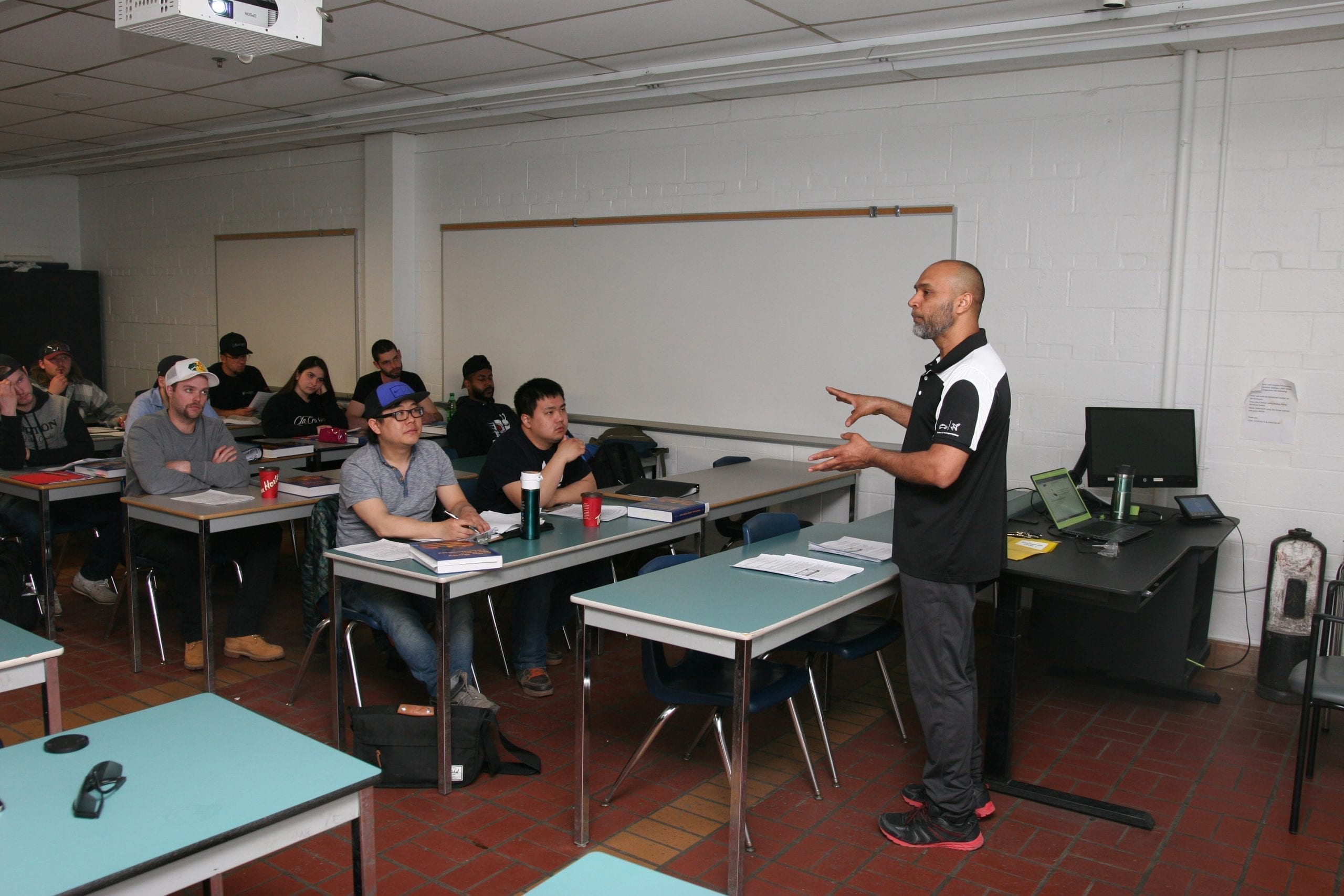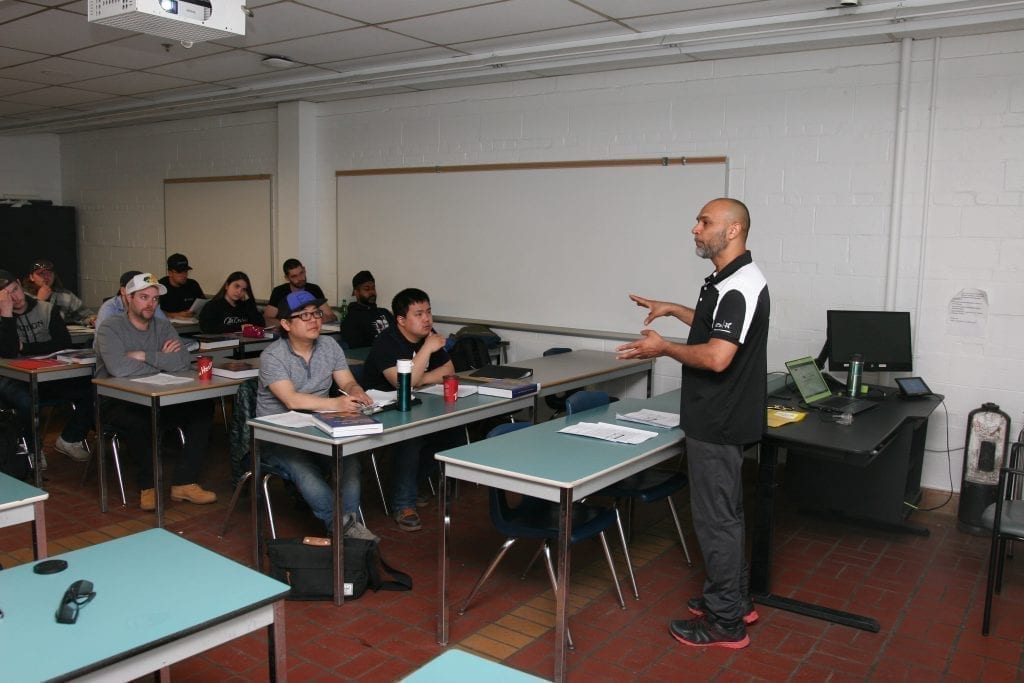A look at Collision Repair for a Student’s Perspective.
In May, Collision Management had the privileged opportunity to go back to school and spend a day in the classroom at Centennial College in Scarborough, Ont.
We followed students in the school’s Auto body Repairer Level 1 program to get an idea of how the next generation of collision repair technicians are preparing themselves for a career in the industry, what their aspirations are and what they feel the industry could benefit from. In our August issue, we’ll get the perspective from schools in different parts of the country and how they are taking steps to ensure the next generation of collision repair technicians are being armed with the tools and techniques needed to succeed.

Back on campus
We began our journey by joining Centennial’s Auto body Repair Level 1 APBD104 Applied Mechanical Theory class led by instructor Ahad Hoosein. In the class, students were given a chance to learn about vehicle electrics, including open and closed circuits and identifying potential faults and the potential root causes of them, such as poor ground connections, corrosion or damage. Diagnosing electrical faults can be one of the most difficult and time-consuming aspects of the repair process and, as both instructor and students discussed, even for experienced technicians, sometimes the way to solve a persistent problem is to go back to the basics. That is why courses such as this often prove invaluable in the long run.
Practical application
Following the morning class session, the students were then invited out to the laboratory for APBD104L practical sessions where they were encouraged to build and test their own circuits and receive feedback based on the results. It was truly fascinating to see how different students went about problem-solving.
From our perspective, it was also very interesting in that we could clearly see how experience gained in the laboratory and through trial and error was already positioning these students for their future careers. Not only was the technical aspect fascinating, so was the collaboration and sharing of ideas between the students and instructor.
And as collision repair becomes ever more complex, the need to collaborate is likely to become ever more important.
Body and frame
After a lunch break, the class regrouped for APBD102 Body Frame & Structure Theory with Instructor Darryl Roberts. In this session, we got to revisit vehicle categories, including size (subcompact, compact, midsize, full-size, truck and SUV) as well as body styles, including coupes, sedans, hardtops and convertibles, plus the type of construction configuration different vehicles employ. These range from unibodies (as found on most passenger cars and crossovers) to sub frames and full-framed vehicles which, today, are largely confined to pickups and traditional SUVs. Different body styles and frame configurations impact how the vehicle is designed, where its key structural strength is and how, when involved in a collision, it can be properly repaired. Following the theory, students were once again invited out to the laboratory to assess a variety of vehicles in the shop, identifying key damage and how each particular vehicle was designed and manufactured. During the day, CM had a chance to chat with some of the students and got them to share their thoughts. Here’s what we found.
Tyler Blake
“Growing up, my dad was really interested in working on cars—he was always tinkering with them—and I really enjoy working on cars myself. There was a job opportunity down the road from my house, so I took it. I want to be a fully licenced collision repair technician, and I want to open my own shop. I’d also like to get into custom work such as chopping tops, shaving door handles, that kind of thing.
I think it’s important for technicians to learn the old school values in the trade—so we can actually properly fix things. At the same time, I also feel it’s important for them to get a proper education so they can properly repair these new cars with all of their electronics.”
Maria Inez Fernandez
“I started at an all-female body shop when Iwas 16 years old as a co-op student. I worked my way up in the industry, and I felt this course was the next step for me.
I would like to be a fully licenced technician and do some customization work on the side. I think we need more females in the industry and get the word out.”
Keegan Sample
“I have been fascinated by cars my whole life. I have gone to a lot of shows—and worked on different types of cars both old and new for seven or eight years. I felt this program was the next logical step—it was perfect, and I felt comfortable in this industry.
I want to be an auto body technician, but I want to have knowledge and experience in different areas including bodyrepairs and paint. I want to be able to have confidence and the experience to tell if there is a problem and know exactly what we can do in the shop to fix it.
I think it’s important to have the hands-on aspect in learning in this industry and make it fun as well. The grants are amazing, but we need to be in a position where more people will know about and consider a career in the trades.”
Mason Tyler Norlock
“You have to take this course to get your full licence, so I wanted to come here and learn as much as I could and focus on it. I want to make sure I can get my licence because it is important to have fully licenced body technicians in your collision shop.
I got into this trade because I didn’t know where else to go at the time. My friend’s dad owned a body shop—so I started tinkering there and sweeping the floors. I got curious about how everything worked, so I started doing it. I ended up doing work on my own cars and friends’ cars, including race cars.
I felt it was important to follow through and get my licence. I think most of the cars these days are going hybrid and electric, and there are going to be a lot more computer related tasks for people to do, which can be difficult for body technicians because we aren’t often engineers. I think for training we are going to have to focus more on wiring and electronics. It will be best for the trade to do that.”



